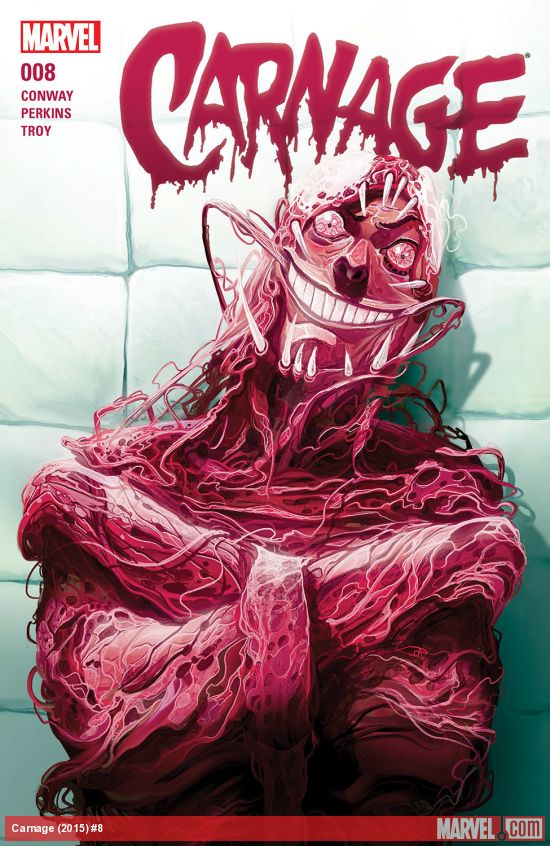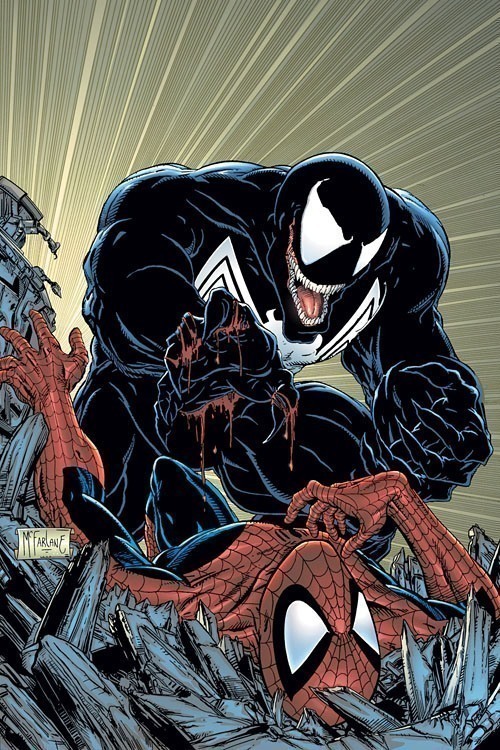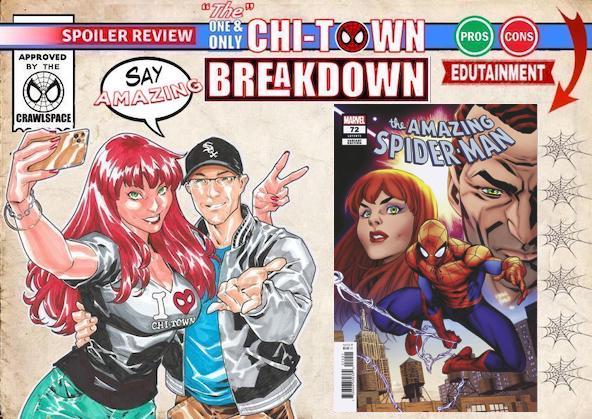 The Brotherhood of Chthon has plans for Carnage, but can they deal with Cletus Kasady? The landscape darkens in this latest chapter of Carnage’s foray into Marvel’s supernatural corner.
The Brotherhood of Chthon has plans for Carnage, but can they deal with Cletus Kasady? The landscape darkens in this latest chapter of Carnage’s foray into Marvel’s supernatural corner.
WRITER: Gerry Conway
ARTIST: Mike Perkins
COLOR ARTIST: Andy Troy
LETTERER: VC’s Joe Sabino
COVER by Mike Del Mundo
EDITOR: Darren Shan
EXECUTIVE EDITOR: Nick Lowe
STORY (with commentary): In Jakarta, Indonesia, Carnage tracks down three members of the Chthonic Brotherhood and demands to know where to find “Brother Gregori” (who’s named after an obscure Dr. Strange and Werewolf-by-Night character named Gregory Russoff, a werewolf). After he kills two of the three members of the brotherhood, Carnage is distracted by the Darkhold Dwarf (another character from the 90’s preternatural books who functions as an agent of Chthon), who issues a cryptic warning to Cletus, demonstrating some strange power over the symbiote and allowing the remaining member of the Brotherhood to escape. The survivor tracks down Brother Gregori, who is also apparently a tool of the Dwarf, by the docks just as Gregori is paying off the owner of the Caspian Sea (the boat that was blown up at the beginning of issue #6) and tells him that the “Red Slayer” has arrived. Gregori outfits the brotherhood with magic weapons that will allow them to subdue Carnage, which they then do (this somewhat redeems the serious misstep from #4 when those Chthonic monks in the mine subdued Kasady with similar weapons – now we know it’s because of magic runes). As Gregori brings a chained Carnage aboard the Caspian Sea, preparing to disembark for the coordinates from issue #6, Cletus figures out that the runes only bind the symbiote and not himself (again, and I’m admittedly nitpicking at this point, there really shouldn’t be much of a distinction here – the symbiote has replaced Cletus’ blood – for all intents and purposes, their symbiosis is perfect and they are practically one being), so Cletus has the symbiote recede, he falls into the ocean, reemerges as Carnage, and cuts off all of the cultists’ hands. He corners a now cowering Gregori and presumably forces him to relay more information about this “sacred altar stone” that is supposed to be at these coordinates out at sea.
Carnage is distracted by the Darkhold Dwarf (another character from the 90’s preternatural books who functions as an agent of Chthon), who issues a cryptic warning to Cletus, demonstrating some strange power over the symbiote and allowing the remaining member of the Brotherhood to escape. The survivor tracks down Brother Gregori, who is also apparently a tool of the Dwarf, by the docks just as Gregori is paying off the owner of the Caspian Sea (the boat that was blown up at the beginning of issue #6) and tells him that the “Red Slayer” has arrived. Gregori outfits the brotherhood with magic weapons that will allow them to subdue Carnage, which they then do (this somewhat redeems the serious misstep from #4 when those Chthonic monks in the mine subdued Kasady with similar weapons – now we know it’s because of magic runes). As Gregori brings a chained Carnage aboard the Caspian Sea, preparing to disembark for the coordinates from issue #6, Cletus figures out that the runes only bind the symbiote and not himself (again, and I’m admittedly nitpicking at this point, there really shouldn’t be much of a distinction here – the symbiote has replaced Cletus’ blood – for all intents and purposes, their symbiosis is perfect and they are practically one being), so Cletus has the symbiote recede, he falls into the ocean, reemerges as Carnage, and cuts off all of the cultists’ hands. He corners a now cowering Gregori and presumably forces him to relay more information about this “sacred altar stone” that is supposed to be at these coordinates out at sea.
 Meanwhile, the exposition-tools that we know as this book’s supporting cast (looking forward to them having more of a purpose in this comic again) fly to Indonesia and discuss the Darkhold. Montesi tells them about the origins of the Darkhold, having been written before the fall of Atlantis by an elder god of the Marvel U, who “ruled the cosmos before creation” (which Brock, being a [crappy] Catholic, calls bullshit – nice character touch), and that it and artifacts like it drives anyone who reads them insane. When they arrive in Jakarta, Montesi tells the cast about Brother Gregori and explains the allusion to the werewolf, of which Col. Jameson (Man-Wolf) takes notice. But before he can get more out of Montesi on the subject, her informant tells her about the events at the docks. The supporting cast then rushes to the coast to find a fast ship, hoping to catch Carnage before he does any more damage, while the Darkhold Dwarf watches and grins from a distance. To be continued. . .
Meanwhile, the exposition-tools that we know as this book’s supporting cast (looking forward to them having more of a purpose in this comic again) fly to Indonesia and discuss the Darkhold. Montesi tells them about the origins of the Darkhold, having been written before the fall of Atlantis by an elder god of the Marvel U, who “ruled the cosmos before creation” (which Brock, being a [crappy] Catholic, calls bullshit – nice character touch), and that it and artifacts like it drives anyone who reads them insane. When they arrive in Jakarta, Montesi tells the cast about Brother Gregori and explains the allusion to the werewolf, of which Col. Jameson (Man-Wolf) takes notice. But before he can get more out of Montesi on the subject, her informant tells her about the events at the docks. The supporting cast then rushes to the coast to find a fast ship, hoping to catch Carnage before he does any more damage, while the Darkhold Dwarf watches and grins from a distance. To be continued. . .
ANALYSIS: This is the second issue we’ve spent playing catch-up, and I for one am losing a bit of interest. I feel like the last two issues’ worth of story could have been compressed into one. That being said, it was another fun and creepy romp into Marvel’s occult corner, albeit one I found myself a bit bored with.
Case in point: Barry Gleason. We finally find out what happened to him at the end of issue #5 in one of the photos that Montesi shows the supporting cast: Carnage killed him. Not that I really care about Gleason as a character all that much, but his confrontation with Carnage was written as this big cliffhanger moment at the end of the first arc. And here, it’s just dismissed as the narrative awkwardly rushes to catch up with events that transpired two issues ago. Again, Gleason wasn’t really all that interesting of a character to begin with, and I’m fine with Carnage just killing him and moving on as, well, that’s Kasady for you, but it’s just awkward storytelling. I thought Conway was going to go somewhere with it. *yawn* Oh well. . .
However, I am liking how Carnage is proving to be incontrollable by the cult. They keep  trying to fit Carnage into their agenda and he’s just not having it. It’s nice because a Cletus Kasady story, to its core, is one about madness and ethics, not the preternatural. His unwillingness to cooperate with the occult designs of the villains in this title, to me, is a nice nod to the fact that Carnage doesn’t really belong in this setting. And I applaud the storytellers here because despite this square-peg-meets-round-hole situation, the book is still pretty interesting and, as I’ve said before, is a direction that Carnage has never really been taken. I know I said I was beginning to get a bit bored, but that’s not with the book’s premise and direction, much less the story itself, which I find myself surprisingly fascinated with, it’s with the storytelling choices. I hope that at this book’s climax, Conway delivers an intelligent and creative portrayal of magic vs. madness.
trying to fit Carnage into their agenda and he’s just not having it. It’s nice because a Cletus Kasady story, to its core, is one about madness and ethics, not the preternatural. His unwillingness to cooperate with the occult designs of the villains in this title, to me, is a nice nod to the fact that Carnage doesn’t really belong in this setting. And I applaud the storytellers here because despite this square-peg-meets-round-hole situation, the book is still pretty interesting and, as I’ve said before, is a direction that Carnage has never really been taken. I know I said I was beginning to get a bit bored, but that’s not with the book’s premise and direction, much less the story itself, which I find myself surprisingly fascinated with, it’s with the storytelling choices. I hope that at this book’s climax, Conway delivers an intelligent and creative portrayal of magic vs. madness.
And behind the scenes of this book, according to the credits Devin Lewis has been removed from the Assistant Editor position. Is this because he’s not doing the job anymore or because he was brought in as a fill-in for last issue because the other two Spider-Editors who work on this book were busy? Whatever. Don’t care. Marvel comics are still too expensive and we still don’t have a letters page in this comic.
CONWAY’S OCCULT CORNER: Since every issue of this title is filled with references to the real world occult, I figured I’d reserve a portion of my reviews for some commentary on these allusions. So, starting this issue, welcome to Gerry Conway’s Occult Corner!
“The Darkhold is a compendium of secrets beyond mortal comprehension. . . It offers both great rewards and greater risks. Just remember, in the end you don’t use the Darkhold. It uses you.” – the Darkhold Dwarf
“First it empowers, then it destroys.” – Victoria Montesi
These quotes from both sides of this story’s conflict are surprisingly honest portrayals of the nature of magic. Witchcraft, Satanism, Wicca, the occult, all of that crap to its core is about one thing: the illusion of power. It is all an attempt to gain a quality or quantity of control that is not natural to the human being. From making fire in one’s hand, to casting love spells, to cursing one’s enemies, to straight-up demonic possession, magic is all an attempt to impress one’s will upon some aspect of nature through unnatural means. And, as all of the Marvel U’s magic books are now portraying, that has a cost (which, for Spidey, according to Spider-Man/Deadpool #5, is perpetual “Emptiness,” which I found to be a meta-commentary on the state of his character since OMD). You hear stories about these people who make “deals” with some “spirit” for some kind of wealth, pleasure, power, or honor who, after the term of their agreement is up, end up as hollow shells of their former selves (e.g. every Spider-Man appearance since OMD). Whether or not you believe that such suffering is due to some preternatural force or a natural process is beside the point. What I’m saying is that there is a great deal of curiosity and interest in the supernatural on display in the popular consciousness nowadays. Marvel, attempting to be the “world outside your window” has picked this up. There are tons of supernatural references in Marvel books now that have never really dealt with them to such a degree. While I think that it is easy to develop an unhealthy level of curiosity and fascination with these dark affairs, and that Marvel is teetering on the edge of that particular precipice, I do somewhat applaud the House of Ideas for portraying this cost more honestly than most. Present comic included: thank you Gerry Conway.
As always, thank you to Gerry Conway, Mike Perkins, and co. for another fine issue of this title, and to you my fellow Crawlspacers for reading and commenting. See you in June for “Sea Devil” part 4.
GRADE:
C
Average (another middling effort in a pretty interesting comic with a good hook, but fatiguing storytelling choices)










I appreciate your comments about the occult. I was unhealthily preoccupied with the occult as an angry young teen, and 1970s Marvel was part of what fed into that (though ultimately I was responsible for my own choices).